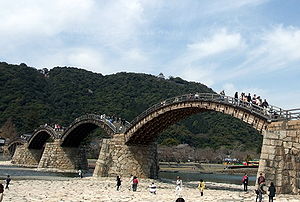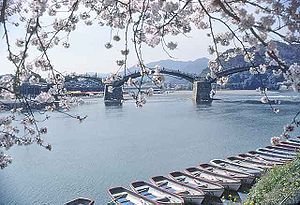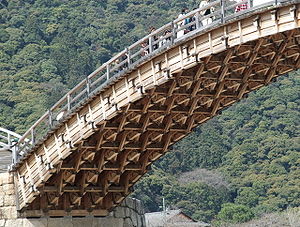
Kintai Bridge
Encyclopedia



Arch bridge
An arch bridge is a bridge with abutments at each end shaped as a curved arch. Arch bridges work by transferring the weight of the bridge and its loads partially into a horizontal thrust restrained by the abutments at either side...
, in the city of Iwakuni
Iwakuni, Yamaguchi
is a city located in Yamaguchi, Japan.On March 20, 2006, the old city of Iwakuni absorbed the towns of Kuga, Mikawa, Miwa, Nishiki, Shūtō and Yū, and the village of Hongō, all from Kuga District, to form the new, expanded city of Iwakuni.- History :...
, in Yamaguchi Prefecture
Yamaguchi Prefecture
is a prefecture of Japan in the Chūgoku region on Honshū island. The capital is the city of Yamaguchi, in the center of the prefecture. The largest city, however, is Shimonoseki.- History :...
, Japan
Japan
Japan is an island nation in East Asia. Located in the Pacific Ocean, it lies to the east of the Sea of Japan, China, North Korea, South Korea and Russia, stretching from the Sea of Okhotsk in the north to the East China Sea and Taiwan in the south...
.
The bridge was built in 1673, spanning the beautiful Nishiki River
Nishiki River
The is a 110 km long river, the longest in Yamaguchi Prefecture, Japan. The Nishiki is the main river in a larger system measuring 331.8 km in total. The government of Japan classifies it as a second-class river system. The Nishiki River system drains an area of 884.2 km².The...
in a series of five wooden arches, and the bridge is located on the foot of Mt.Yokoyama, at the top of which lies Iwakuni Castle
Iwakuni Castle
is a castle in Iwakuni, Yamaguchi, Japan.-History:This castle was constructed by Kikkawa Hiroie from 1601 to 1608 as his own castle.Kikkawa was a retainer of a vassal of the Shogun under the Mōri clan...
.
Declared a National Treasure in 1922, Kikkou Park, which includes the bridge and castle, is one of the most popular tourist destinations in Japan, especially for the Cherry Blossom festival
Sakura
A cherry blossom is the flower of any of several trees of genus Prunus, particularly the Japanese Cherry, Prunus serrulata, which is sometimes called sakura after the Japanese . Many of the varieties that have been cultivated for ornamental use do not produce fruit...
in the spring and the autumn color change of the Japanese Maples.
History
After Iwakuni CastleIwakuni Castle
is a castle in Iwakuni, Yamaguchi, Japan.-History:This castle was constructed by Kikkawa Hiroie from 1601 to 1608 as his own castle.Kikkawa was a retainer of a vassal of the Shogun under the Mōri clan...
was built in 1601 by Kikkawa Hiroie
Kikkawa Hiroie
' was a Japanese daimyo of the Azuchi-Momoyama period through early Edo period.Hiroie's father was Kikkawa Motoharu and his mother was a daughter of Kumagai Nobunao. He initially was named Tsunenobu and made his debut on the battle field on 1570 against Amago Katsuhisa with his father...
, the first lord of Iwakuni Domain
Iwakuni Domain
The ' was a Japanese domain of the Edo period, located in Suō Province .-List of lords:*Kikkawa family #Hiroie#Hiromasa#Hiroyoshi#Hironori#Hiromichi#Tsunenaga#Tsunetomo#Tsunetada...
, a series of wooden bridges were built, all of which were destroyed by floods several times before the construction of the iconic Kintai Bridge. It was built in 1673 by the third lord, Kikkawa Hiroyoshi, new stone piers replaced the old wooden ones and it was thought to be flood-proof; however, the bridge was still destroyed by a flood the next year. As a result, they redesigned the stone piers for greater strength, and a special tax was created to maintain the bridge. This maintenance consisted of being rebuilt periodically: every 20 years for 3 spans in the middle, every 40 years for 2 spans connecting to the riverside. In this way, the bridge was not destroyed by floods again until 1950 by flooding from typhoon "Kezia." It had been in a weakened state at the time, both because the Japanese had stopped maintaining the bridge during World War II
World War II
World War II, or the Second World War , was a global conflict lasting from 1939 to 1945, involving most of the world's nations—including all of the great powers—eventually forming two opposing military alliances: the Allies and the Axis...
and the year before the typhoon, to expand the US Marine Corps Air Station in Iwakuni
Marine Corps Air Station Iwakuni
Marine Corps Air Station Iwakuni or MCAS Iwakuni is a United States Marine Corps air station located in the Nishiki river delta, southeast of the Iwakuni Station in the city of Iwakuni, Yamaguchi in Japan.-Tenant commands:...
, a large amount of gravel
Gravel
Gravel is composed of unconsolidated rock fragments that have a general particle size range and include size classes from granule- to boulder-sized fragments. Gravel can be sub-categorized into granule and cobble...
was taken by the US Military Force
United States Marine Corps
The United States Marine Corps is a branch of the United States Armed Forces responsible for providing power projection from the sea, using the mobility of the United States Navy to deliver combined-arms task forces rapidly. It is one of seven uniformed services of the United States...
from the river around the bridge, strengthening the flow of the river. In 1953, the bridge was once again reconstructed using very similar techniques to the original; however, they used metal nails (made from the same tatara iron as the Katana
Katana
A Japanese sword, or , is one of the traditional bladed weapons of Japan. There are several types of Japanese swords, according to size, field of application and method of manufacture.-Description:...
) to increase its durability. This 1953 reconstruction, partially restored in 2001 and 2004, still stands today.
Architecture
The bridge is composed by five sequential wooden arch bridges on four stone built piers as well as two of wooden piers on the dry riverbed where the bridge begins and ends. Each of the three middle spans is 35.1 meters long, while the two end spans are 34.8 meters for a total length of about 175 meters with a width of 5 meters.Original Construction
For nearly three hundred years the many versions of the bridge stood without the use of metal nails. They achieved this by careful fitting of the wooden parts and by building up thick girders by clamping and binding them together with metal belts. The main wooden parts of the bridge would then be covered by sheets of copper.Flood protection
The shape and weight of the bridge made it extremely strong from the top, but incredibly weak from underneath, flood water rushing along the river would simply lift the bridge up and wash it downstream. So the bridge was designed so that the wooden pathway merely "floats" on top of the frame of the bridge by using mortise and tenonMortise and tenon
The mortise and tenon joint has been used for thousands of years by woodworkers around the world to join pieces of wood, mainly when the adjoining pieces connect at an angle of 90°. In its basic form it is both simple and strong. Although there are many joint variations, the basic mortise and tenon...
joints. This would allow rising flood waters to simply lift out the pathway and carry it off down stream while sparing the main structure.
Kintai-kyô Bridge
is the name of this bridge it was built in 2007
Access
- Iwakuni Station on Sanyo Main Line
- Nishi-Iwakuni Station or Kawanishi Station on Gantoku LineGantoku LineThe is a railway line operated by West Japan Railway Company in western Japan connecting Iwakuni Station in Iwakuni, Yamaguchi Prefecture and Kushigahama Station in Shūnan, Yamaguchi Prefecture....
- Shin-Iwakuni StationShin-Iwakuni Stationis a train station in Iwakuni, Yamaguchi Prefecture, Japan.-Adjacent stations:...
on Sanyō ShinkansenSanyō ShinkansenThe is a line of the Japanese Shinkansen high-speed rail network, connecting Shin-Ōsaka in Osaka with Hakata Station in Fukuoka, the two largest cities in western Japan...
- From these stations, it is still necessary to take a bus or taxi.
See also
- Iwakuni CastleIwakuni Castleis a castle in Iwakuni, Yamaguchi, Japan.-History:This castle was constructed by Kikkawa Hiroie from 1601 to 1608 as his own castle.Kikkawa was a retainer of a vassal of the Shogun under the Mōri clan...
- the bridge was placed as one of the gates of the castle - Nishiki RiverNishiki RiverThe is a 110 km long river, the longest in Yamaguchi Prefecture, Japan. The Nishiki is the main river in a larger system measuring 331.8 km in total. The government of Japan classifies it as a second-class river system. The Nishiki River system drains an area of 884.2 km².The...
- the bridge spans the river

